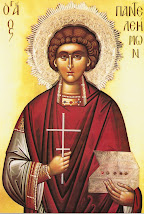In each Orthodox place of worship the faithful will always find, at the center of the Sanctuary, the holy altar table. It is upon this table that the Word of God rests in the text of the Holy Gospels and it is upon this table that our Lord is sacrificed offering His gifts on behalf of all and for all. It is no wonder that some Orthodox theologians would consider the Holy Altar Table to be the seat or place of Christ in the Church.
The practice of the ancient church was simply to celebrate the "breaking of bread" on a simple wooden table not unlike that used in the Last Super. In time though, the place on which the bread was broken changed from common wooden tables to the righteous tombs of those men and women of the faith who were persecuted and martyred in the name of our Lord. This practice evolved into the use of marble altar tables (reminiscent of tombs) in which the precious relics of the martyrs of the Church are housed.
Although the altar table has developed over time, the Church has remained steadfast to the practice of a priest only celebrating one Eucharistic celebration, the Divine Liturgy, from one altar table on a particular day. An early Father of the Church, Saint Ignatios (about 37-105) instructs the Christians to "hold one Eucharist; for one is the flesh of our Lord Jesus Christ; one is the cup of union with His Blood; then there should be one altar as there should be one bishop." A large community with a number of priests may in fact celebrate two liturgies, however, in the spirit of this tradition each liturgy would have a different chief celebrant who would serve at different altar tables.
Today, the Altar Table is covered with two cloths. The first cover next to the flesh of the table, the katasarkion, is reminiscent of the shroud placed on our Lord in the tomb upon His burial. It is placed on the table upon its consecration by the bishop and remains there permanently as the very Body of our Lord has sanctified it. The second and often richly ornate cloth placed on the table stems from a gesture of the Emperor Constantine in the Church of the Holy Wisdom in Constantinople. As an offering of respect and love Constantine brought forth a beautiful cloth "gold threaded and adorned with precious stones" to cover the table which houses the relics of the martyrs and upon which is placed the precious gifts of our Lord and Savior Jesus Christ. Today, members of the body of Christ offer beautiful altar covers in like manner.
Ο Χριστιανισμός στη Μέση Ανατολή
-
Ο Χριστιανισμός έχει βαθιές ρίζες στην Εγγύς και στη Μέση Ανατολή, αλλά
σήμερα αποτελεί μειονοτική θρησκευτική πίστη σε μεγάλο μέρος της περιοχής.
Ο χά...
23 hours ago











































No comments:
Post a Comment